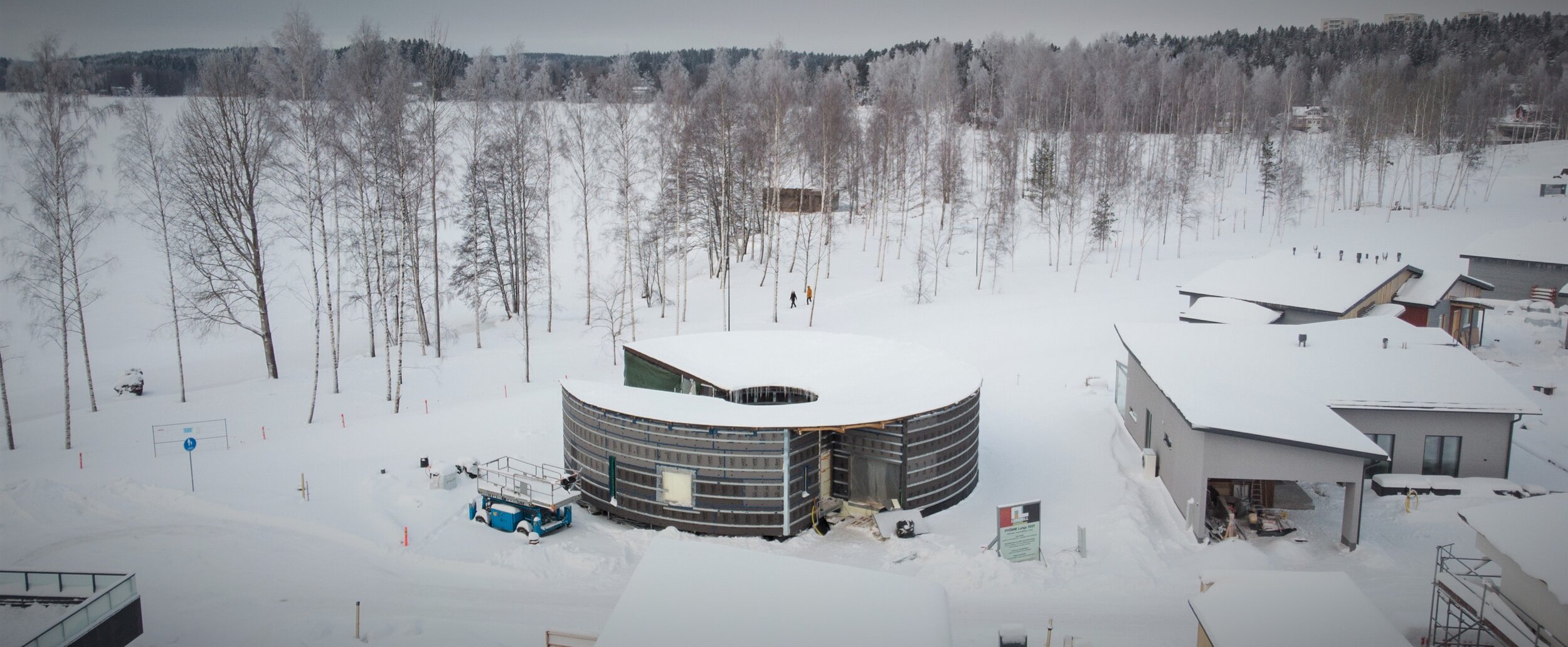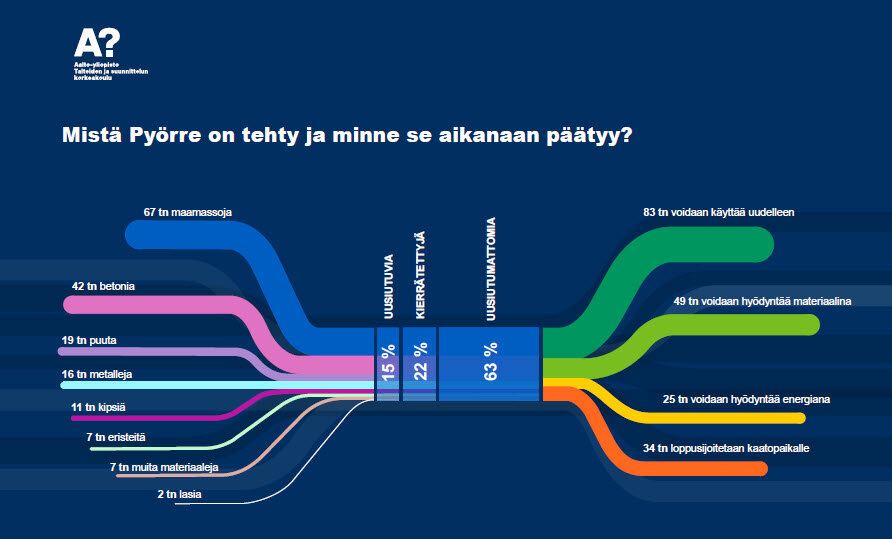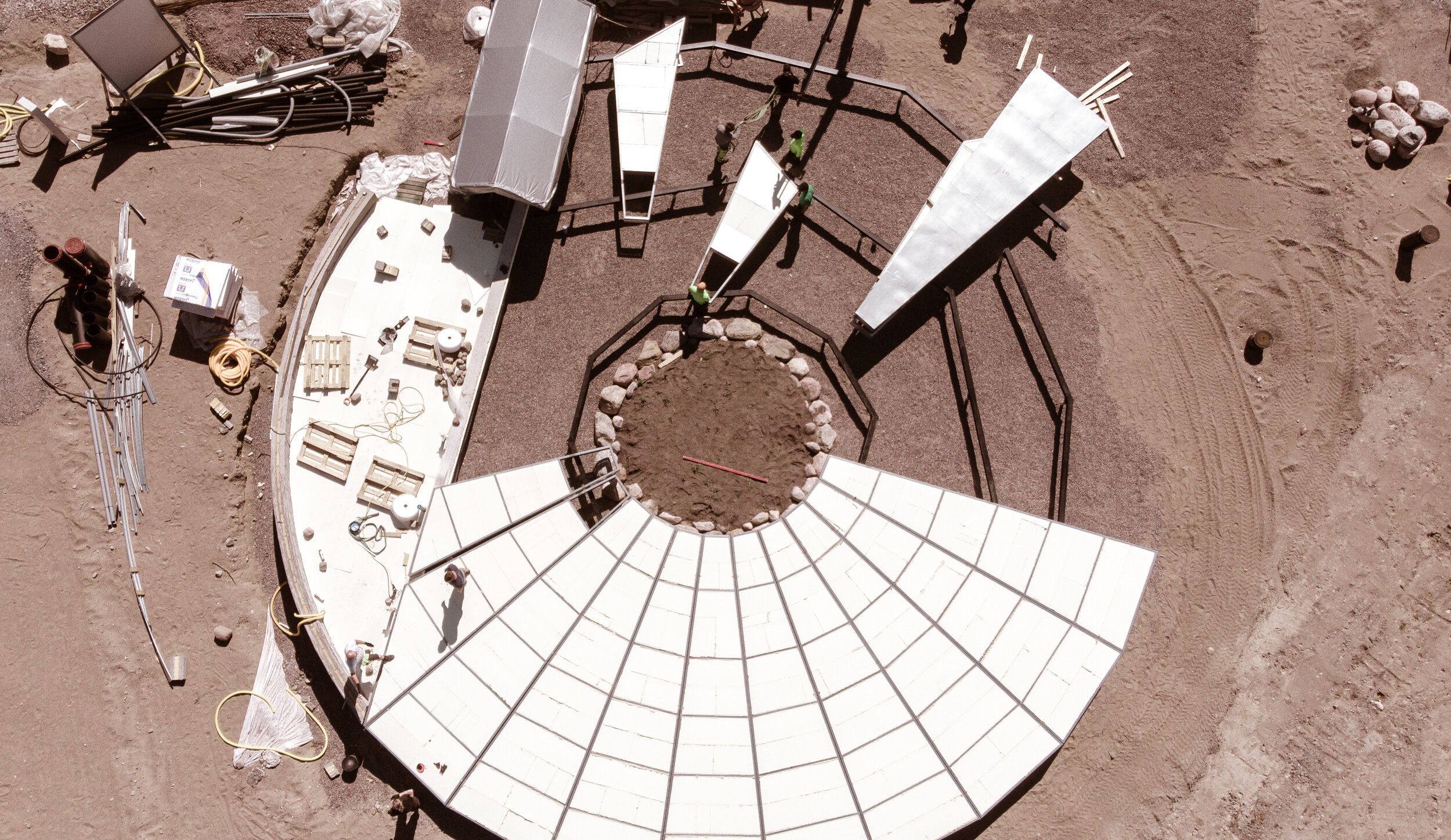Pyörre-talo
Suomi on menossa kohti vähähiilistä rakentamista hiilineutraaliustavoitteiden mukaisesti, rakennusmateriaalien erilaiset vahvuudet huomioiden
Teräksellä on hiilineutraaliuden kannalta parhaat käyttö- ja kierrätettävyysominaisuudet.
Teräs on kiertotalouden kannalta paras rakennusmateriaali.
Puurakentamisella on ansionsa, tosin hiilineutraaliin rakentamiseen tarvitaan muitakin materiaaleja.
Vähähiilisyyden arviointimenetelmässä on hyvä huomioida valmistus, käytönaikaisen ja purkamisen päästöt, sekä rakennusosien ja -materiaalien kierrätyksestä ja uudelleenkäytöstä tulevat hyödyt. Teräsrakenteiden kierrätys toimii tänä päivänä jo lähes sataprosenttisesti. Kierrätetystä teräksestä sulatetun ns. romuteräksen hyödyntäminen pienentää uuden teräksen valmistuksen hiilidioksidipäästöjä radikaalisti – jopa 80 prosenttia. Teräsrakenteet ovat helposti uudelleenkäytettävissä kehittyneiden liitostekniikoiden ansiosta.
Pohjoismaissa siirrytään 20 vuoden aikana asteittain täysin hiilidioksidivapaan teräksen valmistamiseen SSAB:n ansiosta. Tällä on suuri globaalinen vaikutus ja iso vaikutus myös kotimaassa.
Rakennusteollisuus ry:n ja Rakli ry:n tiekartat osoittavat, että rakennus- ja kiinteistöalan sekä hallinnon yhteisillä ponnistuksilla hiilineutraalisuustavoitteet ovat toteutettavissa Suomen asettamassa aikataulussa. Kiinteistö- ja rakennussektorilla, mukaan lukien rakennuttajat, rakennusliikkeet ja rakennustuoteteollisuus, on siinä tärkeä rooli.
Uusien ilmastoystävällisten vaihtoehtojen kautta lisätään tehokkuutta, kilpailukykyä ja elinkaarilaatua
Teräsrakentaminen ja teräkseen perustuvat rakennustuotteet ja palvelut edustavat vuotuiselta liikevaihdoltaan noin miljardin euron toimialaa Suomessa, josta 40 % määrästä on vientiä. Teräsrakentaminen on ainoa rakennustuoteteollisuuden ala, missä on merkittävää lopputuotteiden vientiä. Teräsrakenneala on myös merkittävä työllistäjä alihankintaketjuineen.
Rakentamisen arvoketjua on vahvistettava monipuolisesti kohti hiilineutraalia suunnittelumallia, jolla osaltamme vaikutamme ilmastonmuutoksen torjumiseen. Teräkseen pohjautuvien rakennustuotteiden käytön tukeminen ja yleistyminen ovat tärkeässä roolissa, kun lisätään ilmastollisesti kestävien materiaalien valikoimaa suomalaisessa rakentamisessa. Kiertotalous on tärkeä kehittämiskohde rakentamisessa. Resurssien tehokas käyttö ja jätteeksi päätyvän materiaalin radikaali vähentäminen edellyttävät kiertotalousperiaatteiden käyttöönottoa nopealla aikataululla.
Teräs on ikuinen
Teräs on yksi harvoista materiaaleista, jonka kierrätys on aidosti suljettua. Terästä ei kuluteta. Sitä käytetään yhä uudestaan laadun tai vahvuuden kärsimättä. Useimmista materiaaleista poiketen teräksen laatua ja vahvuutta voidaan parantaa kierrätyksen yhteydessä.
Tästä syystä teräs on ekologisesti kestävä materiaali. Terästehtaat ja -jakelijat pyrkivät tekemään tuotteita vastuullisilla ja parhaita käytäntöjä noudattavilla prosesseilla ja menettelyillä. Ne vähentävät osaltaan maailmanlaajuisesti resurssien käyttöä, sekä kierrättävät ja uusiokäyttävät mahdollisuuksien mukaan materiaaleja, ja auttavat luomaan tämän mahdollistavia talous- ja hankintakehyksiä.
Teräsrakentaminen
Teräsrakenneteollisuus on vuosikymmenten ajan kehittänyt kulutusta ja kosteutta kestäviä kevytrakennejärjestelmiä ja -elementtejä, sekä elementtirakentamisen kiinnitys- ja liitostekniikoita. Keveytensä ansiosta ne ovat myös ergonomisia rakennustyömailla työskentelevien kannalta. Järjestelmät ja tekniikat sopivat rakenteisiin niin kerrostaloissa, liiketiloissa ja julkisissa rakennuksissa kuin omakotitaloissakin.
Pyörre osallistuu kolmeen EU hankkeeseen
Pyörre -talossa tutkitaan sekä vähähiilisyyttä että kiertotaloutta. Rakennuksessa pyritään maksimoimaan kierrätettyjen, kierrätyskelpoisisten ja uusiutuvien materiaalien osuus. Käytetyt materiaalit dokumentoidaan ja visualisoidaan tuoteselosteeksi. Pyörre on mukana ympäristöministeriön vähähiilisen rakentamisen pilotissa, jossa kehitetään eri rakennustyypeille sopivaa tapaa hiilijalanjäljen ja hiilikädenjäljen arviointiin. Lisäksi talon suunnittelussa kokeillaan EU:n muunneltavuuden, purettavuuden ja kierrätettävyyden suunnittelukriteereitä ensimmäisenä suomalaisena rakennuksena. Kaikki tulokset raportoidaan ja havainnollistetaan asukaslähtöisesti siten, että vihreän rakentamisen ja asumisen valinnat tulevat konkreettisiksi ja ymmärrettäviksi.
JULKISIVU JA RUNKO
Termoranka- ja termorankaelementit ovat moderni runkoratkaisu ja sen ansiosta lämmöneristävyys on hyvä ja runko itsessään on luotettava kokonaisuus tämän päivän rakentamiseen. Pyörteen julkisivut on valmistettu Lundell-Profile termorangasta.
VÄLISEINÄT
Elämätön rakenne tulee väliseinistä, joissa runkona on Gypsteel® ranka. Pyörteen seinissä on Habito® kipsilevy ja Gypsteel -rangat 66 ja 95 mm runkosyvyydellä.
ALAKATTO
Alaslaskettu katto on Gypsteel® -alakattorangasta. Markkinoiden ainoa alakattostandardien mukainen kokonaisuus jokaista yksityiskohtaa myöden. Uutena myös testattu paloluokitus 02/2021.
ALAPOHJA
Termorankaelementteinä ja tietysti Pyörteessä ne ovat kakkuviipaleina.



